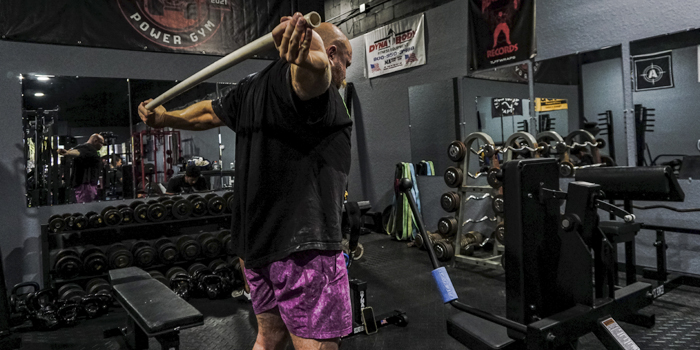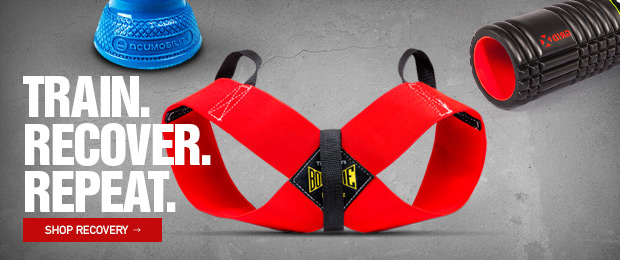
We don't want to be limited by pain any longer than we have to be. We want our rehab to be as efficient and effective as possible. To determine how we should go about the rehab process the right way, we will talk about how people tend to go the wrong way.
We'll talk about how to make your rehab process suck, keep you in pain, and keep you afraid of using your body.
Why are we going to talk about what won't work? Well, if we know what isn't going to get us back under the bar, we know what not to do. If we know the wrong way, it becomes easier to see what is right. If we know why the wrong way is wrong, we can understand why we should be doing things differently.
If you're stuck in pain, this list will help you figure out why.
1. Sit there and wait for it to feel better.
If you don't want to get back under the bar, make sure you do NOTHING to rehab an injury. Complete rest is key here. Time heals all wounds, right?
Well, kind of. The healing process will take time. And yes, while healing occurs, we don't want to stress our tissues beyond what they can handle. But, if we want to heal strong, and if we want to be ready to train when we feel good enough to train, we need to start to use whatever it is that's hurt.
I was told to rest completely to get over my patellar tendinopathy; to not use my knee at all. Rest made it feel better until I'd train. It would feel fine until I put some weight on the bar, then bam, back to as bad as ever—if not worse. What gave?
By resting completely, I wasn't doing anything to prepare that patellar tendon to handle squatting. Since it wasn't prepared to squat, no wonder squatting made it feel worse. Even during the healing process, the body will respond to the stressors we place on it. If we want to be ready to train, we need to place our bodies under the right amount of stress to drive adaptation without making things worse. We need to gradually ask more and more of ourselves through our rehab process.
2. Believe that you are unfixable.
If you never want to feel better, convince yourself you can't. If you can't improve, then why even bother trying?
I was here with my right shoulder for far too long. A shattered humerus, a fractured scapula, multiple collarbone breaks, multiple dislocations, and multiple surgeries through my youth left me with a shoulder that always hurt, didn't want to move, and was beginning to undergo arthritic changes.
I thought my shoulder was the way it was and would only worsen as the arthritis progressed. I thought there was nothing I could do about it, so I didn't do anything about it. It only got worse. Thankfully, I was introduced to Dr. David Hunter's work and began questioning the role of "wear and tear" in osteoarthritis. I started to train my shoulder to gain control of my end range and gradually progress where that end range was. Soon after, my shoulder started to feel AND work better. Movements like dips or overhead presses that used to set me back for weeks began to feel therapeutic.
Realizing that I could do something for my shoulder allowed me to do something for my shoulder. That realization brought progress that previously seemed impossible.
3. Rely on passive treatments.
What is a passive treatment? It's a treatment that is done to you. Passive treatment is where you lay on a table, and someone else does something to your body: a poke, a prod, a jab, a rub, a soundwave, an electrical impulse, etc. And if you want to stay in pain, passive treatment is the ONLY treatment you will do.
I'm not against passive treatment as a whole—it WILL help you feel better. I am against relying on only passive treatment and expecting yourself to make progress.
The problem with relying solely on passive modalities is the difference between feeling better and getting better. Passive treatments operate on a modification of sensory pathways, so we push on some receptors here, we jiggle some stuff there, and we can change our perception of a joint or tissue. That change of perception can be HUGE for allowing us to do more and scale our way back to activity, but only if we put in the work to drive progress. If we don't do anything to raise our capacity, the road back to 100% will be a long one.
Early in my lifting career, my elbows SUCKED. I did what everyone told me to do: tissue work, Graston, shockwave, and dry needling. It did help me get through a session, but I would have to go back for more in a few days. I could train, but it still hurt, sucked, and wasn't getting better.
On a trip to Ohio in 2016, Dave Tate (accidentally) cured my elbow pain. He made fun of my triceps and told me to do rolling extensions. They were extremely painful at first, but I got better at them. As I got better, my elbows began to feel better and better until they were no longer an issue.
Passive treatments can help in the short term, but it's going to be progressively training the injured area that will be a long-term solution.
4. If you're going to do active rehab, don't do it often.
If you are being proactive and using movement to drive your rehab, it'll be harder not to get better, but we can still get the job done. If you don't want to get better, only do your rehab work once a week, or better yet, once a month.
On the rare occasion when a patient is not making progress, I'll ask them: "How often are you doing the work?" If they aren't moving forward, the answer seldom is, "Often enough."
In the initial stages of rehab, when a patient is limited by pain, the movements we prescribe will be relatively easy. Read: low in range of motion, low in loading, and low in complexity. We're not going to ask them to do a lot when they can't do a lot. With early rehab, the amount of work they will get from a single rep will be TINY compared to the work they want to do in training or competition. We can make up for that discrepancy in workload by using frequency as a driver for progress until they can become more intense.
How much will a cat-cow do for your low back compared to a max-effort deadlift? Not a lot, right? But, if your back is too painful to do any deadlifting, let alone max effort, we need to start you somewhere. For that cat-cow to have any carryover back to your deadlift, you'll have to do them OFTEN to create the stimulus and adaptation necessary to progress towards more challenge.
5. Don't progress things as you gain ability.
So, you're doing the little things often enough to get the ball rolling. How can we still make sure you don't make it back to the platform?
Don't progress those little things once they become easy. Remember, a cat-cow might be all someone can do at first, but the stimulus is tiny compared to a deadlift. A cat-cow can get someone on their way to deadlift again, but to be able to deadlift with confidence, you'll need some intermediate steps.
After graduation, one of my first patients was a lifter experiencing repeated back tweaks. They'd feel better, try to pull heavy, and pop she'd go. When talking to her, she expressed, "I do my McGill Big 3 every day. I don't understand why I can't deadlift heavy." The problem wasn't the McGill exercises; she hadn't done enough to bridge the gap from Birddogs and Rolling Planks back to a heavy deadlift.
Bridging that gap could be as simple as scaling load on deadlifts to match the lifter's preparedness. We could also break things down and challenge individual components of the deadlift with something like back raises, single-leg RDLs, loaded hip flexion, and loaded rotation.
If we gradually build ourselves up so we can handle more, we will be able to handle more, as long as we don't overstep along the way. If we want to be stronger and be able to handle training, we need to progress in what we are doing so that we can get stronger and can handle more.
6. Be afraid of pain.
Even if you are doing everything else right, we can guarantee that your progress will be limited if you avoid pain through rehab.
It isn't that we should try to feel pain. We aren't trying to make things worse, but if we have been injured, we should expect that things won't always feel great on the way back. Some pain should be expected. Some pain will be necessary as we challenge ourselves more and more. Some pain does not mean that you made things worse. Even a lot of pain doesn't always mean more damage has been done.
Through rehab, we want to ensure we are doing enough to drive progress but not so much that we hold ourselves back. How are we going to do that? We are going to listen to our bodies. We are going to be aware of any pain we are feeling. We are going to be okay with some discomfort
and pain, but we aren't going to force ourselves to do something that feels sketchy or like it's doing damage.
Dealing with pain through the rehab process isn't like walking a tightrope, as there will be some wiggle room. Think of it like an elementary school hallway with boogers smeared all over the walls. You don't want to touch the walls, but you're not going to die if you do. We aren't trying to avoid pain; we aren't trying to make it hurt; we are doing our best to cruise down the middle of that hall. Not doing enough and doing too much will have similar results in the end.
Conclusion
If we've been injured, we now know what to avoid. We shouldn't sit and wait for it to feel better, believe that we are unfixable, rely on passive treatments, and skip out on progression.
We should be proactive about our rehab process, challenge ourselves often, and progress in what we are doing as we can handle more. Treat rehab like training. Challenge yourself appropriately and take responsibility for your outcomes; you'll come back and better than ever.
Header image credit: Meana Albersworth
Seth Albersworth is a powerlifter with experience in and out of gear. His best totals are 2105 pounds raw and 2408 pounds multi-ply. Seth has completed his bachelor's degree in kinesiology from the University of Calgary and recently graduated from Palmer College of Chiropractic's Florida Campus. He's in the process of acquiring licensure as a Doctor of Chiropractic.











1 Comment